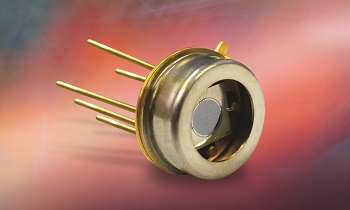Opto Diode, a division of ITW, introduces the SXUVPS4, a new multi-element detector with a 5 mm² active area in a quadrant configuration. Designed to resist radiation damage from high intensity UV lasers, the SXUVPS4 photodiodes are ideal for laser alignment applications. Offering unmatched stability, the SXUV series of photodiodes are the only commercially available detectors that can withstand 4 days of exposure to 10 eV 1016 photons/cm2 without degradation in responsivity.

The new photodiode features excellent responsivity providing 0.125 to 0.02 A/W over a 10 to 200 nm wavelength range. The large circular detection surface is optimized for precise alignment of lasers with 4 elements, each offering 1.25 mm² active area. The compact TO-5 package allows for easy integration into new or existing systems.
As with all Opto Diode products, the new quadrant photodiodes are designed to maximize measurement repeatability and reliability. For more information about Opto Diode’s new SXUVPS4 quadrant 5 mm² photodiode, go to: http://optodiode.com/pdf/SXUVPS4.pdf. To view the photon responsivity graph, please scroll to page two of the data sheet.
Opto Diode Corporation (www.optodiode.com) based in Camarillo, California has a long history of delivering industry-leading photodetectors and LEDs. Available in standard and custom designs, Opto Diode products have supported the photonics industry for over 30 years and earned a reputation for high performance, superior quality and reliability. With the acquisition of International Radiation Detectors (IRD) and the merger of Cal Sensors (CSI), Opto Diode now offers industry-leading performance detectors from the extreme UV to the mid-infrared (mid-IR) regions of the electromagnetic spectrum. The IRD product line detects high energy particles and photons in the UV and X-ray regions. The CSI detectors provide superior sensitivity to discriminate trace gases or detect heat, sparks or flames in the mid-IR spectrum.
Complemented by high performance LEDs with radiometric emissions from 365 to 940 nm and IR emitters covering 1 to 10 microns, Opto Diode supports your measurement needs from prototyping to high volume production. All products are designed and manufactured in the US. The Opto Diode facility is optimized for manufacturing with on-site wafer fabrication, class 1,000 to 10,000 clean rooms, extensive assembly capabilities and packaging expertise, delivering the products you need to fulfill your design requirements. Applying rigorous quality control standards, Opto Diode serves a variety of industries including: medical, test & measurement, military/defense, biotechnology, R&D, entertainment, industrial, aerospace and automotive. For more information, visit www.optodiode.com.